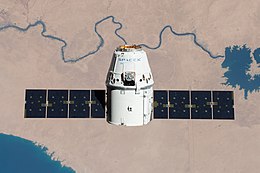 | |
| Names | SpX-11 |
|---|---|
| Mission type | ISS resupply |
| Operator | SpaceX |
| COSPAR ID | 2017-030A |
| SATCAT no. | 42744 |
| Mission duration | 29 days, 15 hours, 4 minutes |
| Spacecraft properties | |
| Spacecraft | Dragon 1 C106 |
| Spacecraft type | Dragon 1 |
| Manufacturer | SpaceX |
| Dry mass | 4,200 kg (9,300 lb) |
| Dimensions | Height: 6.1 m (20 ft) Diameter: 3.7 m (12 ft) |
| Start of mission | |
| Launch date | 3 June 2017, 21:07:38 UTC[1] |
| Rocket | Falcon 9 Full Thrust (B1035) |
| Launch site | Kennedy Space Center, LC-39A |
| End of mission | |
| Recovered by | MV GO Searcher |
| Landing date | 3 July 2017, 12:12 UTC[2] |
| Landing site | Pacific Ocean off Baja California |
| Orbital parameters | |
| Reference system | Geocentric orbit |
| Regime | Low Earth orbit |
| Inclination | 51.66° |
| Berthing at International Space Station | |
| Berthing port | Harmony nadir[1] |
| RMS capture | 5 June 2017, 13:52 UTC [3] |
| Berthing date | 5 June 2017, 16:07 UTC [4] |
| Unberthing date | 2 July 2017, ≈18:00 UTC [5] |
| RMS release | 3 July 2017, 06:41 UTC [2] |
| Time berthed | 27 days, 1 hour, 53 minutes |
| Cargo | |
| Mass | 2,708 kg (5,970 lb) [6] |
| Pressurised | 1,665 kg (3,671 lb) |
| Unpressurised | 1,002 kg (2,209 lb) |
 SpaceX CRS-11 mission patch | |
SpaceX CRS-11, also known as SpX-11, was a Commercial Resupply Service mission to the International Space Station, launched successfully on 3 June 2017. The mission was contracted by NASA and was flown by SpaceX. The mission utilized a Falcon 9 launch vehicle and was the first reuse of C106, a CRS Dragon cargo vessel that was previously flown on the CRS-4 mission.
CRS-11 was the penultimate of the first twelve missions awarded to SpaceX under the Commercial Resupply Services contract to resupply the International Space Station.
- ^ a b Clark, Stephen (3 June 2017). "Reused Dragon cargo capsule launched on journey to space station". Spaceflight Now. Retrieved 3 June 2017.
- ^ a b Richardson, Derek (3 July 2017). "Dragon splashes down in Pacific with time-critical experiments". Spaceflight Insider. Retrieved 3 July 2017.
- ^ Clark, Stephen (5 June 2017). "Dragon supply ship delivers to space station for second time". Spaceflight Now. Retrieved 5 June 2017.
- ^ Garcia, Mark (5 June 2017). "Dragon Attached to Station for Cargo Transfers". NASA. Retrieved 5 June 2017.
 This article incorporates text from this source, which is in the public domain.
This article incorporates text from this source, which is in the public domain.
- ^ McDowell, Jonathan (2 July 2017). "The Space Report". No. 739. Jonathan's Space Report. Archived from the original on 1 March 2018. Retrieved 3 July 2017.
- ^ "SpaceX CRS-11 Mission Overview" (PDF). NASA. Retrieved 3 June 2017.
 This article incorporates text from this source, which is in the public domain.
This article incorporates text from this source, which is in the public domain.